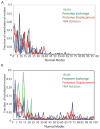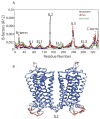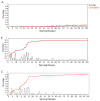Influence of oligomerization on the dynamics of G-protein coupled receptors as assessed by normal mode analysis
- PMID: 17963239
- PMCID: PMC3489929
- DOI: 10.1002/prot.21787
Influence of oligomerization on the dynamics of G-protein coupled receptors as assessed by normal mode analysis
Abstract
The recently discovered impact of oligomerization on G-protein coupled receptor (GPCR) function further complicates the already challenging goal of unraveling the molecular and dynamic mechanisms of these receptors. To help understand the effect of oligomerization on the dynamics of GPCRs, we have compared the motion of monomeric, dimeric, and tetrameric arrangements of the prototypic GPCR rhodopsin, using an approximate-yet powerful-normal mode analysis (NMA) technique termed elastic network model (ENM). Moreover, we have used ENM to discriminate between putative dynamic mechanisms likely to account for the recently observed conformational rearrangement of the TM4,5-TM4,5 dimerization interface of GPCRs that occurs upon activation. Our results indicate: (1) significant perturbation of the normal modes (NMs) of the rhodopsin monomer upon oligomerization, which is mainly manifested at interfacial regions; (2) increased positive correlation among the transmembrane domains (TMs) and between the extracellular loop (EL) and TM regions of the rhodopsin protomer; (3) highest interresidue positive correlation at the interfaces between protomers; and (4) experimentally testable hypotheses of differential motional changes within different putative oligomeric arrangements.
Figures








Similar articles
-
Computational prediction of homodimerization of the A3 adenosine receptor.J Mol Graph Model. 2006 Dec;25(4):549-61. doi: 10.1016/j.jmgm.2006.03.003. Epub 2006 Mar 24. J Mol Graph Model. 2006. PMID: 16781879 Free PMC article.
-
Agonist-induced conformational changes in bovine rhodopsin: insight into activation of G-protein-coupled receptors.J Mol Biol. 2008 Oct 3;382(2):539-55. doi: 10.1016/j.jmb.2008.06.084. Epub 2008 Jul 7. J Mol Biol. 2008. PMID: 18638482
-
Dynamic models of G-protein coupled receptor dimers: indications of asymmetry in the rhodopsin dimer from molecular dynamics simulations in a POPC bilayer.J Comput Aided Mol Des. 2006 Jul-Aug;20(7-8):405-16. doi: 10.1007/s10822-006-9053-3. Epub 2006 Nov 7. J Comput Aided Mol Des. 2006. PMID: 17089205 Free PMC article.
-
The study of G-protein coupled receptor oligomerization with computational modeling and bioinformatics.FEBS J. 2005 Jun;272(12):2926-38. doi: 10.1111/j.1742-4658.2005.04730.x. FEBS J. 2005. PMID: 15955053 Review.
-
Relevance of rhodopsin studies for GPCR activation.Biochim Biophys Acta. 2014 May;1837(5):674-82. doi: 10.1016/j.bbabio.2013.09.002. Epub 2013 Sep 13. Biochim Biophys Acta. 2014. PMID: 24041646 Review.
Cited by
-
Genome-wide Membrane Protein Structure Prediction.Curr Genomics. 2013 Aug;14(5):324-9. doi: 10.2174/13892029113149990009. Curr Genomics. 2013. PMID: 24403851 Free PMC article.
-
Dynamic properties of oligomers that characterize low-frequency normal modes.Biophys Physicobiol. 2019 Nov 29;16:220-231. doi: 10.2142/biophysico.16.0_220. eCollection 2019. Biophys Physicobiol. 2019. PMID: 31984175 Free PMC article.
-
Increasingly accurate dynamic molecular models of G-protein coupled receptor oligomers: Panacea or Pandora's box for novel drug discovery?Life Sci. 2010 Apr 10;86(15-16):590-7. doi: 10.1016/j.lfs.2009.05.004. Epub 2009 May 22. Life Sci. 2010. PMID: 19465029 Free PMC article. Review.
-
Normal mode analysis as a method to derive protein dynamics information from the Protein Data Bank.Biophys Rev. 2017 Dec;9(6):877-893. doi: 10.1007/s12551-017-0330-2. Epub 2017 Nov 4. Biophys Rev. 2017. PMID: 29103094 Free PMC article. Review.
-
Changes in dynamics upon oligomerization regulate substrate binding and allostery in amino acid kinase family members.PLoS Comput Biol. 2011 Sep;7(9):e1002201. doi: 10.1371/journal.pcbi.1002201. Epub 2011 Sep 29. PLoS Comput Biol. 2011. PMID: 21980279 Free PMC article.
References
-
- Muller G. Towards 3D structures of G protein-coupled receptors: a multidisciplinary approach. Curr Med Chem. 2000;7:861–888. - PubMed
-
- George SR, O’Dowd BF, Lee SP. G-protein-coupled receptor oligomerization and its potential for drug discovery. Nat Rev Drug Discov. 2002;1:808–820. - PubMed
-
- Filizola M, Weinstein H. The structure and dynamics of GPCR oligomers: a new focus in models of cell-signaling mechanisms and drug design. Curr Opin Drug Discov Dev. 2005;8:577–584. - PubMed
-
- Milligan G. G-protein-coupled receptor heterodimers: pharmacology, function and relevance to drug discovery. Drug Discov Today. 2006;11:541–549. - PubMed
Publication types
MeSH terms
Substances
Grants and funding
LinkOut - more resources
Full Text Sources

